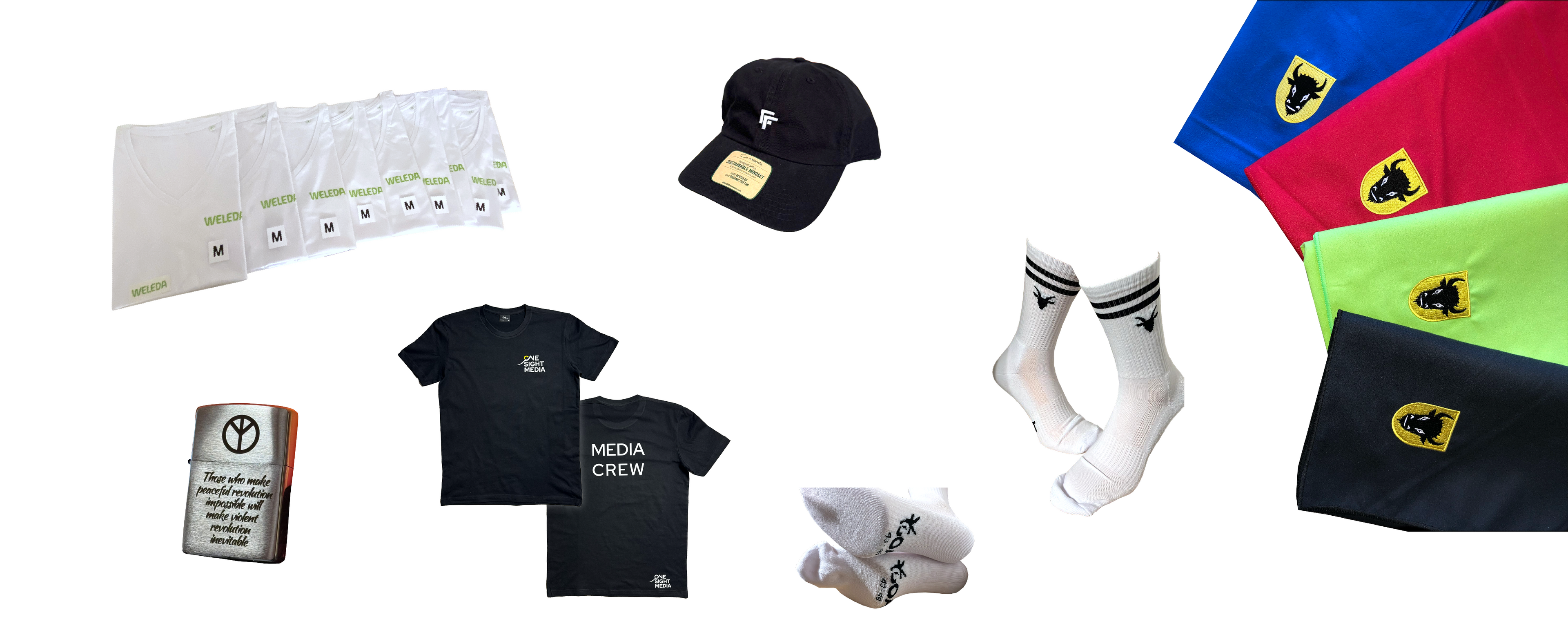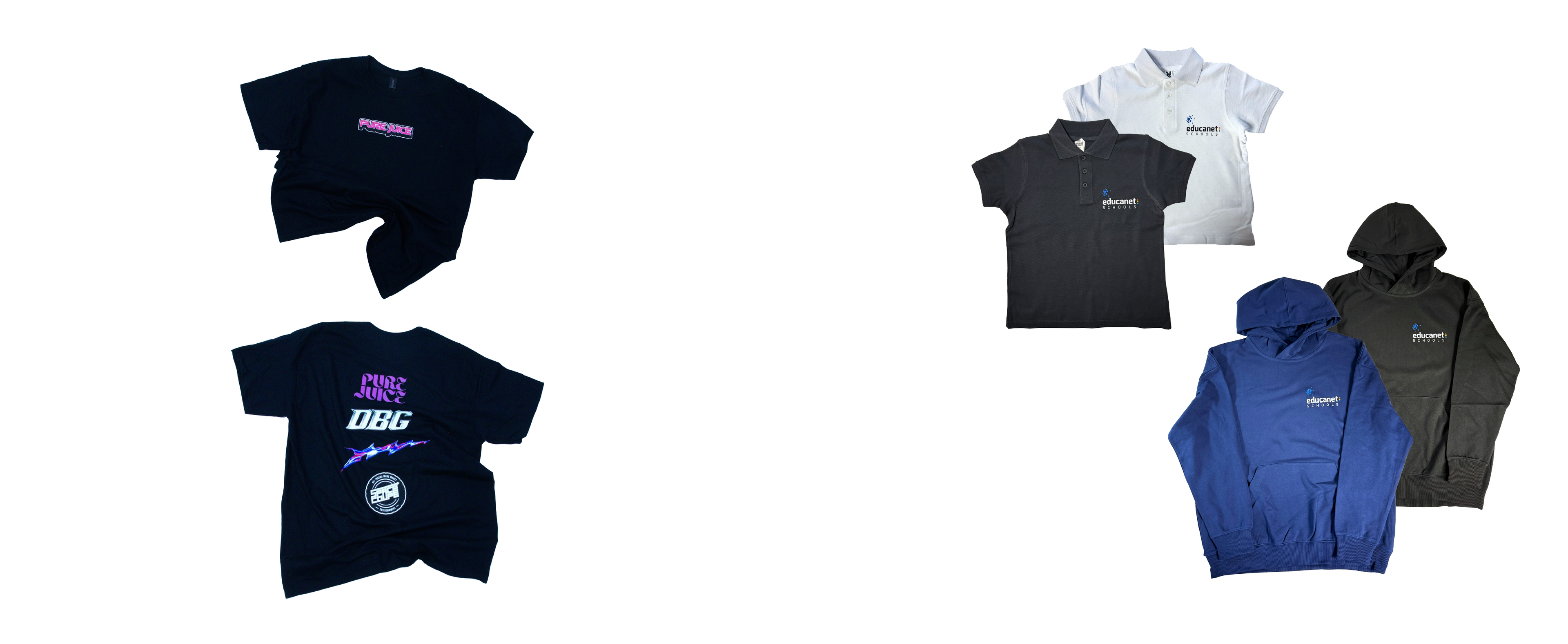The B2B guide to t‑shirt printing: technologies, costs, and timelines for EU teams
Branded t‑shirts and polos are one of the most visible touchpoints a company can deploy at events, activations, onboarding, and retail. The right print or stitch method determines how the garment looks on day one and after 50+ washes, how color holds under stage lights, and whether logos stay crisp on textured fabrics.
Below is a practical, execution‑ready guide you can plug into procurement and creative workflows.
Core technologies: when to use which
- Screen printing
Best for larger runs with solid spot colors and bold shapes. Ink is pushed through a mesh screen onto the fabric, creating a thick, durable layer.
Unit cost decreases as quantity increases because setup (screens, color separations) is amortized. Ideal for brand marks, slogans, and graphic tees where color fidelity (Pantone matching) matters.
Works great on mid‑weight cotton (e.g., 190–200 g/m² ring‑spun) and blends. Avoid ultra‑fine gradients; convert to halftones or simplify artwork.
- DTF (Direct‑to‑Film)
Artwork is printed onto a film, powdered with adhesive, cured, and heat‑pressed to the garment. Delivers full‑color prints with photographic detail and strong wash resistance. Excels with complex logos, small batches, and multiple variants (names, departments) across sizes.
Suitable for cotton, polyester, and many performance blends. Slight hand (feel) is present; for oversized graphics.
- DTG (Direct‑to‑Garment)
Inkjet printing directly onto pre‑treated fabric; great for rapid prototyping, short runs, and on‑demand drops.
Best on high‑cotton content and light colors for maximum vibrancy. Colors are layered by CMYK + white; durability is good for casual wear but typically below heavy screen print under high abrasion.
Use DTG for intricate artwork on limited editions, internal merch, or test market campaigns where speed trumps per‑unit cost.
- Heat transfer / vinyl
Perfect for personalization—names, numbers, roles—and simple one‑color elements. Pairs well with screen‑printed base designs for hybrid orders.
Choose stretch vinyl for sportswear; ensure peel type (hot/cold) and press specs match the textile to avoid edge lift. Not ideal for large, solid coverage due to hand and breathability.
- Embroidery
The premium option for logos on polos, hoodies, beanies, aprons, and heavier tees. Thread is stitched into the fabric using a digitized file that defines stitch types, density, and underlay.
Extremely durable, colorfast, and elevated in texture and perception. Specify thread type (rayon for sheen, polyester for strength and wash resistance), backing (cutaway vs. tear‑away), and stitch density for clean edges.
Avoid very small type; consider a satin stitch or simplify micro‑details. On thin tees, request soft backing and lower density to prevent puckering.
Quality signals buyers should demand
- Fabric specs: Define fiber content and weight (e.g., ring‑spun 190–200 g/m² cotton) for hand feel and print performance. Ring‑spun reduces fuzz; tighter knit yields sharper edges.
- Color control: Require Pantone references, test strikes, and daylight/LED viewing. For embroidery, thread charts mapped to Pantone help.
- Pre‑treatment & curing: DTG needs consistent pre‑treat; screen and DTF require correct flash/press temps and dwell. Ask for temperature/pressure logs.
- Stitch density (embroidery): Over‑dense stitching causes puckering; under‑dense looks patchy. Review digitized proofs and a sewn sample.
- Sample policy: Insist on physical swatches or production‑grade photos from recent EU jobs to validate finish, registration, and color.
Cost, MOQs, and timelines
- Screen print: Setup costs (per color) mean economies of scale at 50–5,000+ units. Lead time typically 5–10 business days depending on colors and approvals. Best cost per unit at scale, especially for 1–3 color designs.
- DTF: Minimal setup—excellent for 10–500 units, many variants, and multi‑location prints. Lead time 3–7 days with stocked blanks. Predictable across textiles; useful for complex art without screen prep.
- DTG: Fast for 1–100 units; same‑week feasible for simple designs. Cost per unit remains relatively high versus screen at volume but wins on speed and flexibility.
- Embroidery: Digitizing fee upfront; efficient from 20–500+ units. Lead time 5–10 days. Pricing depends on stitch count; simplifying micro‑details lowers cost and improves sew quality.
- Urgent orders: Shorten time by using stocked blanks, locking Pantone/thread selections early, and consolidating artwork approvals. Pre‑approve print positions and garment tolerance to avoid rework. Ship partials for event deadlines.
EU compliance and sustainability
Choose REACH‑compliant, OEKO‑TEX‑certified inks and threads; request supplier documentation.
Favor EU‑sourced textiles to reduce transit risk, improve QC, and lower emissions. For embroidery, specify recycled polyester threads where possible and soft, skin‑friendly backings.
Local Czech and broader EU production stabilizes lead‑time variance and gives better control over batch consistency, especially for rolling event calendars.
Design and artwork preparation
- Vectors first: Provide SVG/EPS/PDF with outlined fonts and Pantone references. For raster, supply 300 DPI at print size.
- Simplify for scale: Convert gradients to halftones for screen printing; enlarge small type for embroidery readability.
- Placement templates: Define print/embroidery positions (chest, sleeve, nape), max sizes, and alignment. Include size‑graded placements for XS–XXL so logos sit consistently across garments.
- Color management: For black fabrics, specify underbase strategy (screen/DTF/DTG) to maintain vibrancy; for embroidery, test metallic threads or tonal stitching on brand colors.
What Now?
EU teams needing reliable, fast t‑shirt printing and local compliance can streamline procurement with Czech‑based production, regional logistics, and verified photo references. Explore tailored solutions for marketing, HR, and event use cases.
👉 Book your FREE consultation today or contact us:

Frequently Asked Questions
Most durable method for heavy wear?
Screen printing for flat graphics; embroidery for logos on heavier garments. DTF offers strong durability for complex color on mixed textiles.
Best for small orders with full‑color graphics?
DTF balances detail, durability, and cost for 10–500 units; DTG is ideal for quick prototypes.
Fastest production for urgent deadlines?
With stocked blanks and final artwork, DTF or DTG can ship in 3–5 business days; embroidery typically 5–10 days once digitized.
Recommended fabric weight?
- 190–200 g/m² ring‑spun cotton balances comfort, print sharpness, and longevity.
Are inks and threads EU‑compliant?
Choose OEKO‑TEX, REACH‑compliant inks and threads; request certificates per batch.
Artwork prep tips?
Vectors with Pantone; raster 300 DPI; simplify small details for embroidery; define placements and sizes across garment grades.
Difference between DTF and DTG?
DTF transfers cured film onto fabric for strong durability; DTG prints ink directly—excellent for speed and intricate art on cotton.
Can technologies be mixed?
Yes. Screen for core tees, embroidery for polos/hoodies, DTF for personalization and complex full‑color, DTG for prototypes or limited runs.


